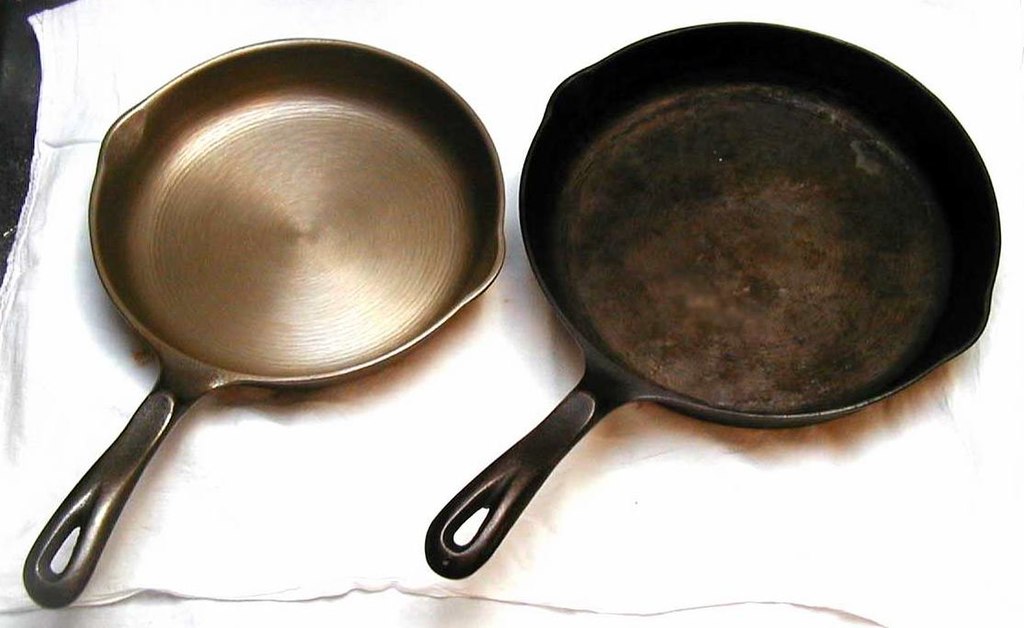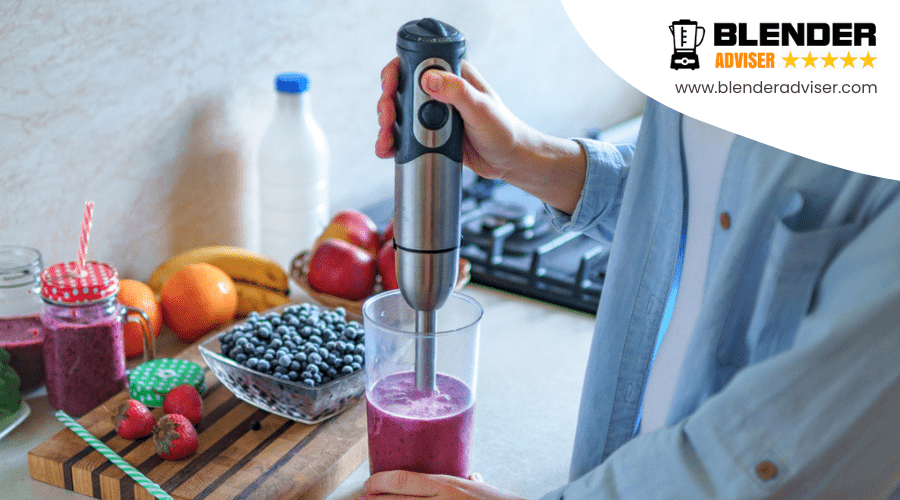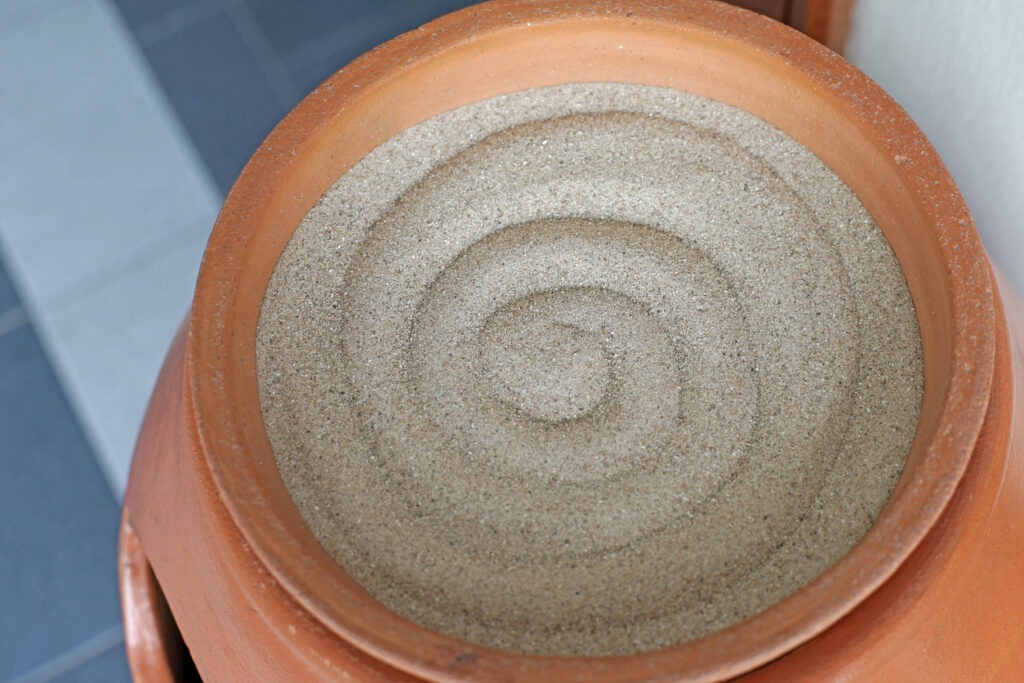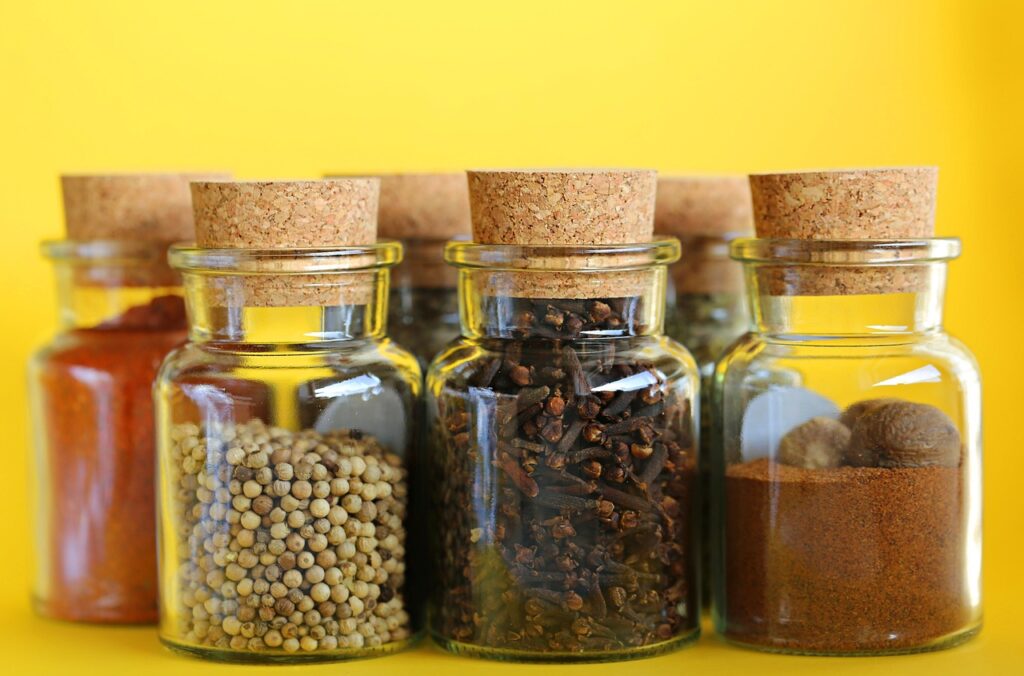You might not realize it, but using your immersion blender in non-stick cookware can actually damage both the utensils and the blender’s blades. While it’s tempting to blend directly in the pot for convenience, the hard metal of the blender can scratch and wear away the non-stick coating, releasing potentially harmful substances into your food.
So, before you go ahead and puree that soup or sauce, consider the implications for your kitchenware and health. This might just prompt you to rethink where and how you use this handy tool, especially when safer alternatives are available.
Non-Stick Cookware Risks

Using an immersion blender in non-stick cookware risks damaging the coating, leading to potential health hazards. When you’re whipping up your favorite smoothie or soup with a hand blender, it’s tempting to blend directly in the pot for convenience. However, the high-speed blades of the hand blender can scratch and chip the non-stick surface of your cookware, compromising not just its effectiveness but also your health. The metal parts of the blender can come into direct contact with the non-stick surface, causing abrasions. Over time, this reduces the lifespan of your cookware and could release harmful chemicals into your food as the damaged coating starts peeling and flaking.
To safeguard your health and extend the life of your non-stick cookware, it’s recommended to use alternative containers like glass, stainless steel, or ceramic when blending. These materials can handle the action of the immersion blender without the risk of damage, ensuring that your food remains safe from potential toxins and that your cookware stays in top condition for longer. So, next time you reach for your hand blender, remember to choose your container wisely to avoid any unnecessary risks.
Blending Hot Liquids
After addressing the risks of using immersion blenders with non-stick cookware, it’s crucial to also consider the dangers of blending hot liquids. When you’re eager to puree your soup or sauce, the convenience of a handheld immersion blender can’t be beaten. However, hot liquids pose a specific challenge. Here’s what you need to know to keep your kitchen mess-free and yourself safe:
- Avoid High Heat: Never use your immersion blender in liquids that are still on a high heat source. The intense heat can cause the liquid to splatter, creating a mess and potentially causing burns.
- Cool Down First: Let hot liquids cool slightly before blending. This doesn’t mean they’ve to be cold, but a moderate temperature reduction can significantly reduce the risk of splattering and ensure a safer blending experience.
- Submerge and Blend Carefully: Always keep the blender submerged to prevent hot liquids from splattering out of the container. Use caution and blend at a lower speed to start, gradually increasing as needed to achieve your desired consistency.
Large Volume Recipes
When tackling large volume recipes, consider that immersion blenders may not be your best tool due to their limited blending capacity. Despite their convenience for smaller batches, when you’re working with big batches, you’re likely to encounter some challenges that can affect the quality of your dish. Immersion blenders simply aren’t designed to handle large quantities of ingredients effectively. This can lead to ineffective blending, where your mix mightn’t achieve the smooth consistency you’re aiming for.
Moreover, pushing an immersion blender to work through large volume recipes can strain its motor and blades. This not only affects the immediate blending results, making them uneven or chunky, but it can also shorten the lifespan of your blender. Imagine trying to blend a huge pot of soup or sauce; the immersion blender struggles to incorporate all ingredients uniformly, leaving you with a less than ideal texture.
For these reasons, it’s advisable to switch to a regular stand blender when dealing with large volume recipes. Stand blenders are built to offer the blending power and capacity needed for such tasks, ensuring that your ingredients blend smoothly and evenly.
Dry Ingredients Challenges
You might find yourself struggling with powder clumping and inadequate blending when you use an immersion blender for dry ingredients. These devices can’t efficiently mix flour or powdered spices, often leading to uneven textures.
You’re better off using a hand mixer or food processor for these tasks to achieve smoother results.
Powder Clumping Issues
Facing challenges with dry ingredients, it’s crucial to acknowledge that immersion blenders may struggle, often leading to powder clumping issues. When you’re trying to blend ingredients like flour or cocoa, these tools mightn’t be your best bet. Here’s why:
- Powders tend to clump together rather than disperse evenly, making your mixture less smooth.
- Dry ingredients can get stuck around the blades, preventing them from moving freely and doing their job.
- The design of immersion blenders isn’t ideal for breaking down these stubborn particles into a consistent texture.
Inadequate Blending Results
Understanding the limitations of immersion blenders with dry ingredients, it’s clear they may not provide the smooth results you’re looking for. Dry ingredients can get stuck around the blades, resulting in uneven mixing and clumping. This can turn blending dry ingredients into a messy and inefficient process. Without liquid, the blender’s blades struggle, failing to achieve a smooth consistency.
For optimal results, consider using alternatives:
| Tool | Best For |
|---|---|
| Hand Mixer | Even mixing and blending |
| Stand Mixer | Large batches |
| Blender | Smooth consistencies |
| Immersion Blender | Not recommended |
Whole Spices Grinding
When grinding whole spices, it’s crucial to avoid using an immersion blender due to its inability to effectively pulverize these tough ingredients. Immersion blenders simply lack the power and design to break down hard spices into a fine powder. This can leave you with unevenly ground spices and a mess to clean up. Instead, consider these three alternatives for achieving the perfect grind:
- Dedicated Spice Grinder: These are designed specifically for the task at hand, ensuring a consistent and fine powder every time.
- Mortar and Pestle: Going old school with a mortar and pestle not only gives you control over the texture but also helps release the natural oils and flavors of the spices.
- Coffee Grinder: A clean, blade-based coffee grinder can double as an effective spice grinder in a pinch, delivering a uniform grind.
Using an immersion blender for spices grinding can also prematurely dull or damage its blades, making it less effective for its intended uses like soups and sauces. So, save yourself the hassle and opt for the right tool for the job. Your dishes (and your blender) will thank you.
Dough and Batter Mixing
Moving onto dough and batter mixing, you’ll find that immersion blenders aren’t your best bet. They can risk improper gluten development, potentially damage the device through overmixing, and lead to inconsistent textures.
You’re better off using a hand or stand mixer for these tasks to achieve the right consistency and texture.
Gluten Development Risk
You should be cautious when mixing dough or batter with an immersion blender, as it can lead to excessive gluten development. When aiming for the perfect texture in your baked goods, remember:
- Hand mixers and stand mixers are your best friends for dough mixing and batter mixing. They offer the control needed to prevent overworking the mixture.
- Immersion blenders can be too aggressive for delicate batters, risking the development of tough and chewy textures.
- Avoid using immersion blenders for recipes that require minimal gluten development, like cake batters or pancake mixes, to ensure a soft and tender outcome.
Choosing the right tool for the job is crucial to achieving the desired texture in your baked delights.
Overmixing Potential Damage
Frequently, using an immersion blender for mixing dough and batter can inadvertently lead to overmixing, resulting in tough and dense finished products. This appliance’s high speed and power can develop gluten in dough much quicker than intended, giving your bread or pastries an undesired chewy texture.
Similarly, when you’re aiming for light and airy cakes or muffins, the vigorous action of an immersion blender can overwork the batter. This affects the final texture, making your baked goods less than perfect.
For these reasons, it’s often better to use your hand or a stand mixer for these tasks. They offer more control when incorporating ingredients, ensuring you avoid the overmixing potential damage that can ruin your delicate recipes.
Inconsistent Texture Issues
While immersion blenders excel in many kitchen tasks, they often fall short in achieving the right texture for dough and batter, leading to inconsistency. The rapid action can overmix, developing gluten that affects tenderness and fails to evenly incorporate ingredients. Here’s why you might reconsider reaching for an immersion blender when mixing dough or batter:
- Overmixing leads to tough textures, unlike the desired lightness in whipped cream.
- Gluten development makes your dough less tender, not ideal when precision is key, such as in making soup or folding egg whites.
- Uneven incorporation of ingredients results in inconsistent outcomes, unlike the uniformity needed in delicate baking tasks.
Hand or stand mixers offer more control and gentleness, ensuring your dough and batter reach the perfect consistency every time.
Hard Foods Limitations
Immersion blenders often struggle with hard foods like ice and tough vegetables, potentially straining their motors and dulling the blades. When you’re tempted to use your blender to crush ice or pulverize root vegetables, remember these limitations. The blades on immersion blenders aren’t as robust as those found in stand blenders, making them less effective for hard items. You might find yourself pushing the device to its limits, risking damage to both the motor and the blades.
Attempting to blend these hard foods not only risks damaging your appliance but can also cause splattering or splashing due to the resistance they offer. This not only creates a mess but might also pose a safety risk if hot liquids are involved.
Moreover, the results you get from trying to process hard foods with an immersion blender are often unsatisfactory. The textures mightn’t be as smooth as you’d like, and you could end up with uneven chunks rather than a consistent blend.
Food Texture Considerations
Considering the limitations of immersion blenders, they’re not the best tool for achieving ultra-smooth textures in your dishes. When you’re aiming for that perfect consistency, whether it’s for a creamy soup or a velvety sauce, the texture of your food really matters. Here’s why you might want to use a high-powered blender instead:
- Tough Ingredients: Foods with tough or fibrous textures, like raw carrots or frozen fruit, can challenge the motor and blade of an immersion blender. A high-powered blender is designed to handle these with ease.
- Ultra-Smooth Consistency: Recipes that require a completely smooth consistency, such as silky pureed soups or velvety sauces, are better suited for a traditional stand blender. It’s simply better equipped to achieve that ultra-smooth texture you’re after.
- Delicate Dishes: When precision control over texture and consistency is critical, especially for delicate dishes or fine sauces, a stand blender offers optimal results. It allows for a more refined and controlled blending process, ensuring your dish turns out exactly as intended.
Cleaning and Maintenance Concerns
To ensure your immersion blender’s longevity and performance, proper cleaning and maintenance are crucial. It’s vital to avoid using your immersion blender for cleaning off tough, dried-on food residue as this can cause damage to the blades. Don’t make the mistake of immersing the motor housing in water or other liquids during cleaning, as this could lead to electrical hazards. You’ll also want to steer clear of abrasive scrubbers or harsh chemicals on the blender’s components to prevent scratches or further damage.
When it comes to blending, avoid processing extremely hot liquids above the manufacturer’s maximum temperature capacity to prevent accidents. This caution helps in maintaining your blender’s integrity and ensures you’re not pushing it beyond its designed limits. Additionally, don’t submerge the entire blender in water for extended periods. This practice can affect the motor and overall performance, leading to potential malfunction or breakdown.
Conclusion
In summary, it’s crucial to know when not to use your immersion blender. Avoid it with non-stick cookware, hot liquids, and large volumes that overwhelm its capacity. It struggles with dry ingredients, can’t effectively grind whole spices, and isn’t suited for mixing dough or batter. Be mindful of hard foods that can damage it, and consider the desired texture of your food. Proper use ensures longevity, so pay attention to cleaning and maintenance to keep it in top shape.





